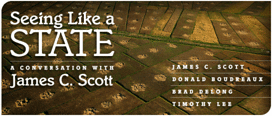Don Boudreaux makes an interesting point about the way standardization facilitates social cooperation and the division of labor. But I think it’s important to remember that the distinctive feature of the state-building projects James Scott describes wasn’t just standardization, but coercion. People were compelled to adopt new surnames, geographical indicators, property boundaries, and the like whether they liked it or not. And most of the time they didn’t like it, because it was obvious that the point of the exercise was to make the populace more amenable to centralized control.
Given how many of the standardized features of modern life have their origins in state-driven projects, it might seem like state compulsion is required to achieve large-scale standardization. But this is not so, as we have an example of an almost perfectly non-coercive standardization project: the Internet.
It’s true that the Internet’s early development was funded by the federal government, and the feds did encourage and subsidize Internet adoption within academia during the 1980s. But the Internet’s most explosive growth happened after the Internet was privatized during the 1990s. The vast majority of nodes on the Internet today joined the Internet after the network had become independent and self-financing. Millions of private organizations joined the Internet because they wanted access to the rapidly growing universe of content it offered.
The Internet offers its users an unprecedented degree of standardization and legibility. Every computer on the network (more or less) is identified by a unique string of 32 ones and zeros known as an IP address. The entire Internet has adopted the Domain Name System, a kind of online “yellow pages” that converts names like “cato.org” or “google.com” into 32-bit IP addresses. And layered on top of that is the Uniform Resource Identifier, or URI, which, as its name suggests, allows anyone in the world to uniquely identify any online resource, such as this blog post.
There’s one crucial difference between this system of legibility and the state-driven systems of legibility that are the focus of Seeing Like a State: the Internet makes it easy to find computers, people, blog posts, and the like, but only if they want to be found. Because there’s no central authority controlling access to the network or verifying that people are who they say they are, individuals on the Internet are free to maintain multiple independent identities or they can decline to identify themselves at all.
This is great for the “idea orgies” Boudreaux lauds, but as we might expect, it drives state officials crazy. There’s a perennial debate in tech policy circles about anonymity on the Internet. Law enforcement officials and assorted busybodies are perpetually complaining that the Internet’s anonymity-friendly architecture facilitates a wide variety of harms, including online harassment, illicit file-sharing, and the spread of child pornography. These critics regularly demand that the Internet be re-architected to facilitate centralized control, although they rarely have a clue about how to do it.
Thus we should be cautious about ascribing the beneficial effects of state-driven standardization projects to state compulsion. Once the state has compelled a nation’s citizens to adopt a standardized scheme, it’s not surprising that private parties begin to use that scheme for their own purposes. But if Boudreaux is right that standardization is economically beneficial, and I think he is, standardization schemes may very well have emerged spontaneously before too long.
And as we see in the case of the Internet, voluntary standardization schemes have a different character than externally imposed ones. Because people adopt them only when and to the extent they’re useful, they tend to be less useful for centralized, coercive projects such as tax collection.
We can see this dynamic at work in the contemporary debate over proposals for a national ID card. Currently, the United States has a de facto system of national identification that consists of the combination of your Social Security Number and state-issued driver’s license. This combination is perfectly adequate for most private interactions; the Social Security Number provides a globally unique identifier that almost everyone has, which can be used for credit checks and the like, and the driver’s license is a pretty good way to establish your identity. But the decentralized and minimalist character of this ad hoc system make it ill-suited for centralized, coercive state projects such as excluding undocumented workers from the labor market.
There has been a growing push to create a standardized national ID card and a national database that ties biometric information to peoples’ Social Security Numbers. Such proposals will do little or nothing to facilitate the kind of voluntary cooperation Boudreaux lauds in his response. Rather, their function is to enhance state control over the American people.
So Boudreaux is absolutely right that standardization begets cooperation, the division of labor, and more. But we should be careful about conflating standardization with coercive centralization. Some standardization projects are much more centralized, and centralizing, than others. State-driven projects are almost always centralizing projects, sometimes with a helpful side-effect of enabling “idea orgies.” In contrast, private-sector standardization projects are primarily information aphrodisiacs, and they can be designed to thwart centralized control.

